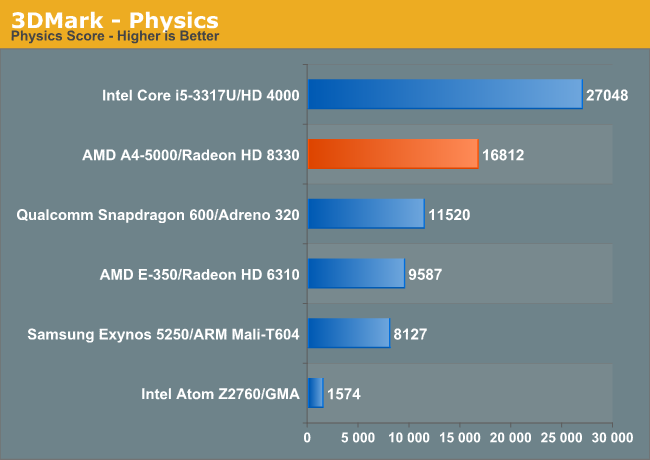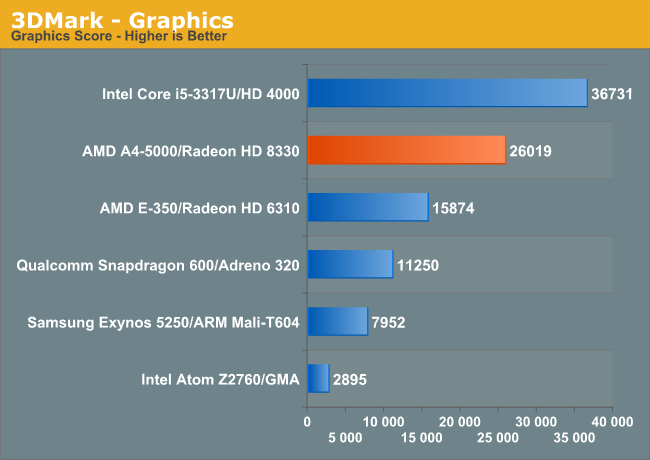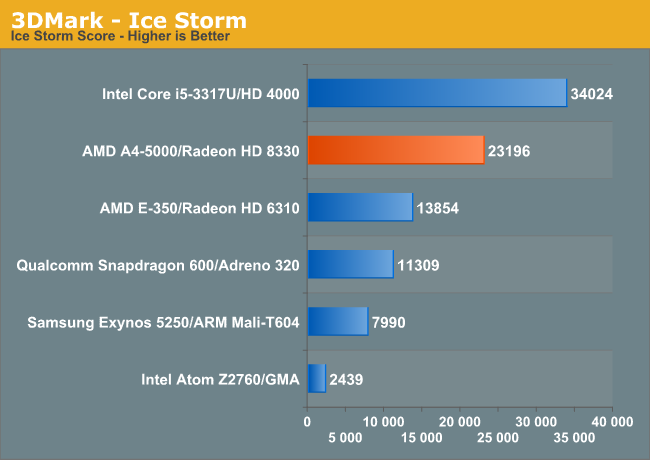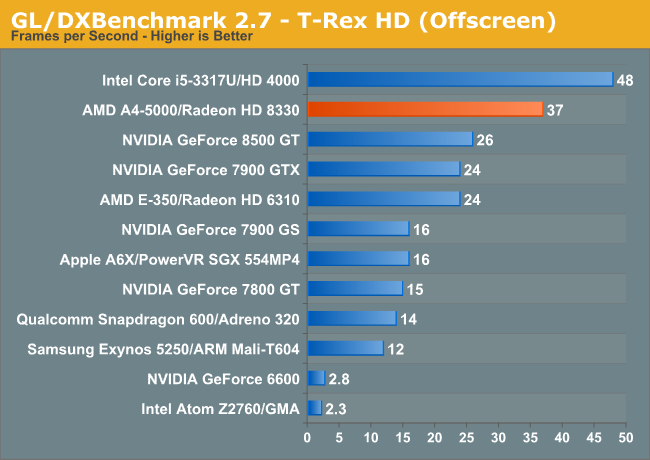The AMD Kabini Review: A4-5000 APU Tested
by Jarred Walton on May 23, 2013 12:00 AM ESTKabini vs CT/ARM: GPU Performance
I pulled out 3DMark and GFXBenchmark (formerly GL/DXBenchmark) for some cross platform GPU comparisons. We'll start with 3DMark Ice Storm and its CPU bound multithreaded physics benchmark:

The physics test is a bit unreasonably multithreaded, which is why we see a 75% uplift compared to AMD's E-350. For FP heavy game physics workloads however, Jaguar does quite well. While a big Ivy Bridge is still going to be quicker, AMD's A4-5000 gets surprisingly close given its much lower cost.
The 3DMark graphics test is more of what we're interested in seeing here. Two GCN compute units (128 SPs/cores) running at 500MHz will really put the old Radeon HD 6310 in Brazos to shame:

The results are quite good. Kabini manages a 61% performance advantage over AMD's old Brazos platform, and actually gets surprisingly close to Intel's HD 4000 in performance. As we discovered earlier, this isn't really enough performance to play modern PC games but casual (and especially tablet) gaming workloads should do wonderfully here.

The overall Ice Storm score just incorporates both physics and graphics test components. As expected, Kabini continues to lead over everything other than the i5-3317U.
Finally we have the GFXBenchmark T-Rex HD test. I threw in a handful of older PC GPUs, although keep in mind that T-Rex HD isn't very memory bandwidth intensive (penalizing some of the old big PC GPUs that had good amounts of memory bandwidth). The test is also better optimized for unified shader architectures, which helps explain the 8500 GT's excellent performance here.

Kabini does very well in this test as well. If we look at the tablet-oriented Temash part (A4-1200) we see that the number of GCN compute units remains unchanged, but max GPU frequency drops to 225MHz from 500MHz. If we assume perfect scaling with GPU clock speed, Temash could offer roughly the same graphics performance as the 4th generation iPad. AMD claims the A4-1200 Temash APU carries a TDP of only 3.9W, a potentially very interesting part from a GPU perspective if our napkin math holds true.
OpenCL Performance
For our last comparison we're looking at the OpenCL performance of these on-die GPUs. We're using a subset of Ryan's GPU Compute workload, partially because many of those tests don't work properly on Kabini yet and also because some of those tests are really built for much more powerful GPUs. We've got LuxMark 2.0 and two CLBenchmark 1.1.3 tests here. Their descriptions follow:
SmallLuxGPU is an OpenCL accelerated ray tracer that is part of the larger LuxRender suite. Ray tracing has become a stronghold for GPUs in recent years as ray tracing maps well to GPU pipelines, allowing artists to render scenes much more quickly than with CPUs alone.
CLBenchmark contains a number of subtests; we’re focusing on the most practical of them, the computer vision test and the fluid simulation test. The former being a useful proxy for computer imaging tasks where systems are required to parse images and identify features (e.g. humans), while fluid simulations are common in professional graphics work and games alike.
| OpenCL GPU Performance | ||||||||||||||||
| LuxMark 2.0 | CLBenchmark—Vision | CLBenchmark—Fluid | ||||||||||||||
| AMD A5-5000 (Radeon HD 8330) | 18K samples/s | 1041 | 1496 | |||||||||||||
| AMD E-350 (Radeon HD 6310) | 23K samples/s | 292 | 505 | |||||||||||||
| Intel Core i5-3317U (HD 4000) | 107K samples/s | 819 | 1383 | |||||||||||||
LuxMark is really a corner case here where Kabini shows a performance regression compared to Brazos. The explanation is simple: some workloads are better suited to AMD's older VLIW GPU architectures. GCN is a scalar architecture that is usually going to net more efficient usage, but every now and then you'll see a slight regression. Intel's HD 4000 actually does amazingly well in the LuxMark 2.0 benchmark.
Our two CLBenchmark tests however paint a very different picture. Here Kabini not only significantly outperforms its predecessor, but is faster than Ivy Bridge as well.










130 Comments
View All Comments
Gigaplex - Thursday, May 23, 2013 - link
I don't think these chips are hUMA yet.silverblue - Saturday, May 25, 2013 - link
I don't think we're even getting that until Kaveri, unless the console setups feature it.HalloweenJack - Thursday, May 23, 2013 - link
why are you including a cpu which isn't in the same market? `hey here's a good AMD APU , but were going to ignore that and put an IB in the graphs for lol factor cause its far better and we don't want AMD to look good for once`. seriously anandtech.haukionkannel - Thursday, May 23, 2013 - link
This could be really nice in 7" to 8" windows8 tablet! Faster than atom, cheap and eat less power. Finally one can get surface pro tablet near 300-400$ and still get resonable good performance...Yeah Haswell ULV will be much faster, but then the cost will be near 1000$ for tablet, I am not so interested in that alternative!
Fanny how AMD can beat intel in ultra portable devices! We really need a new version of Atom to compete with this. Luckily it is coming so we will see some old fachioned competition in that sector! Competetion is good! We just have to see what has happened in highend CPU and see stalling situation in there...
whyso - Thursday, May 23, 2013 - link
This is using way more power than the atom z2760.Gaugamela - Thursday, May 23, 2013 - link
Go check benchmarks for Temash.whyso - Thursday, May 23, 2013 - link
Its still using about twice as much power.z2760 tdp is 1.7-3 watts.
axien86 - Thursday, May 23, 2013 - link
AMD Jaguars destroys Atom Z2760 in performance while costing the same. Consumers win.
silverblue - Saturday, May 25, 2013 - link
With Toms, they were told by AMD that Kabini should be compared to stuff within the same price bracket, hence the Pentium and i3 in their review.Here, AT doesn't have comparable hardware (they don't get sent it).
CajunArson - Thursday, May 23, 2013 - link
Dude.. AMD put together a laptop and shipped it to Anandtech for benchmarking. How is it Anandtech's fault that AMD intentionally chose not to put dual-channel memory into a prototype notebook that it built itself? Instead of blaming Anandtech for being "biased," maybe we should be looking at why AMD chose not to equip its own prototype with dual channel memory?